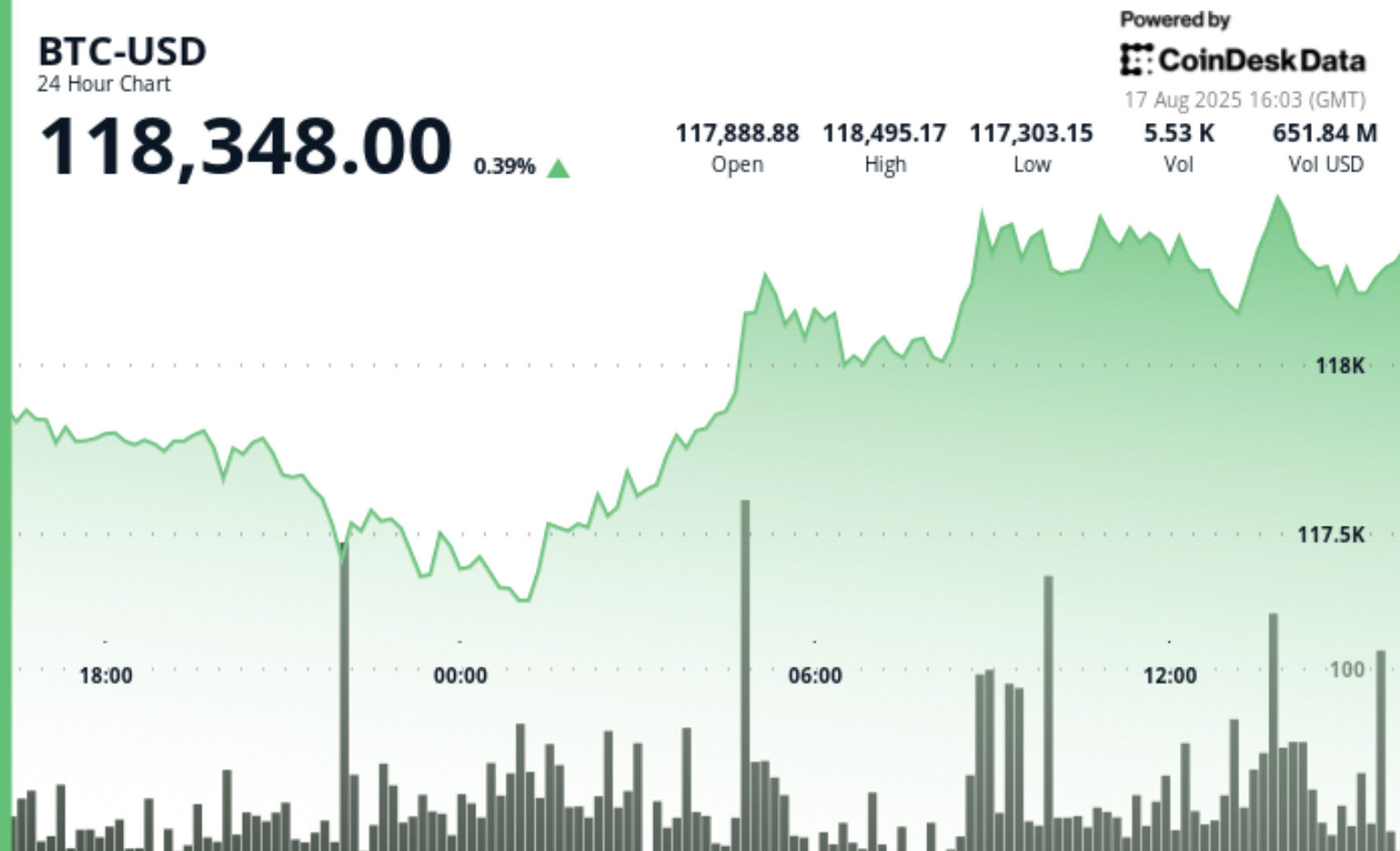-
Back to menu
Prices
-
Back to menu
-
Back to menu
Indices -
Back to menu
Research
-
Back to menu
Events -
Back to menu
Sponsored
-
Back to menu
Videos -
Back to menu
-
Back to menu
-
Back to menu
Webinars
Select Language
By Siamak Masnavi, CD Analytics|Edited by Aoyon Ashraf
Updated Aug 17, 2025, 4:47 p.m. Published Aug 17, 2025, 4:40 p.m.

- Analyst Lark Davis flagged $108K–$112K as a potential retest zone if bitcoin keeps sliding.
- Michaël van de Poppe said BTC could stay rangebound after rejecting resistance.
- Strong support near $117,000 and resistance at $118.6K are shaping BTC’s short-term outlook.
Bitcoin
hovered near $118,348 on Sunday, up 0.39% in 24 hours, as two analysts outlined paths that could test traders’ nerves: a dip toward $108K–$112K or a drawn-out range with room for altcoins.
Lark Davis argues that if bitcoin continues to slide, the most likely landing zone is $108,000–$112,000. That range served as a ceiling earlier this year when bitcoin’s rally stalled, and in market psychology, levels that once blocked price often flip into support when revisited.
STORY CONTINUES BELOW
He emphasizes that this area also aligns with two classic pullback checkpoints known as the 50% and 61.8% Fibonacci retracements. These measures, drawn from the size of bitcoin’s last rally, are widely watched because they often mark where profit-taking slows and new buying emerges. While Fibonacci ratios sound mathematical, in practice they work as self-fulfilling markers since many traders plan entries there.
Davis also points to the 20-week exponential moving average, a trend line that updates quickly with recent price action. When this line is rising into the same $108K–$112K area, it strengthens the case for support, because technical traders see both history and momentum meeting in one zone.
When several signals cluster like this — resistance turned support, Fibonacci checkpoints and a rising average —traders call it “confluence,” and confluence zones often act like magnets for price tests.
In other words, Davis isn’t predicting collapse but a healthy reset. His framework suggests that if bitcoin dips, buyers could step in around that band and fuel the next leg higher.
Michaël van de Poppe takes a different angle, noting that bitcoin was just rejected at a key resistance level near its recent highs. A rejection means sellers absorbed demand as the price tried to break out, a common signal that momentum needs to cool off before the next push. He expects the market to consolidate rather than trend, with bitcoin moving sideways between a floor and a ceiling while leverage resets.
The TradingView chart he shared underscores this. It showed bitcoin making repeated attempts at the top of its range but failing to hold above resistance. The candles formed wicks —price spikes that quickly faded — suggesting selling pressure was active near the highs. Underneath, the chart marked a zone of potential support, where Van de Poppe believes bitcoin could find a base before another breakout attempt.

For van de Poppe, the message is not about deep retracement but time. A sideways range would give the market breathing room, clear out overextended positions, and set the stage for the next move up. It would also open the door to rotation into altcoins, which often outperform when bitcoin stops trending.
That rotation, he suggests, could already be brewing. Once bitcoin stabilizes, traders typically seek higher returns in large altcoins like ether before spreading to smaller tokens. Altcoin rallies rarely start while bitcoin is in freefall, but they often gain momentum when BTC ranges and volatility cools.
In plain terms, the two analysts are describing different but compatible playbooks. Davis favors a deeper pullback into a support cluster that could refresh the uptrend, while van de Poppe sees a range-bound pause with potential for altcoins to shine.
For everyday readers, the checklist is simple: watch whether bitcoin trades sideways or dips to the $108K–$112K zone. In either case, analysts agree the broader bull market framework remains intact, but the path forward could look very different depending on how support and resistance play out in the weeks ahead.
Technical analysis highlights
- According to CoinDesk Research’s technical analysis data model, Bitcoin showed bullish strength in the 24-hour window from Aug. 16, 15:00 UTC to Aug. 17, 14:00 UTC, rising from $117,847.02 to $118,485.32, a 1% gain.
- Support formed near $117,261.72 early on Aug. 17, followed by a break above $118,000 with higher-than-average volume of 2,848.15 BTC during rallies at 04:00, 08:00, 09:00, and 13:00 UTC.
- In the final hour from Aug. 17, 13:17–14:16 UTC, bitcoin climbed from $118,165.31 to $118,397.67, including a sharp move at 13:51–13:52 UTC when price spiked from $118,417.23 to $118,604.10 on 679.81 BTC of volume.
- The move set short-term resistance around $118,600 before consolidating near $118,400, leaving potential for further upside after cooling.
Disclaimer: Parts of this article were generated with the assistance from AI tools and reviewed by our editorial team to ensure accuracy and adherence to our standards. For more information, see CoinDesk’s full AI Policy.
Siamak Masnavi is a researcher specializing in blockchain technology, cryptocurrency regulations, and macroeconomic trends shaping the crypto market. He holds a PhD in computer science from the University of London and began his career in software development, including four years in the banking industry in the City of London and Zurich. In April 2018, Siamak transitioned to writing about cryptocurrency news, focusing on journalism until January 2025, when he shifted exclusively to research on the aforementioned topics.
CoinDesk Analytics is CoinDesk’s AI-powered tool that, with the help of human reporters, generates market data analysis, price movement reports, and financial content focused on cryptocurrency and blockchain markets.
All content produced by CoinDesk Analytics is undergoes human editing by CoinDesk’s editorial team before publication. The tool synthesizes market data and information from CoinDesk Data and other sources to create timely market reports, with all external sources clearly attributed within each article.
CoinDesk Analytics operates under CoinDesk’s AI content guidelines, which prioritize accuracy, transparency, and editorial oversight. Learn more about CoinDesk’s approach to AI-generated content in our AI policy.
More For You
By Will Canny|Edited by Aoyon Ashraf
Aug 17, 2025

A rising bitcoin price is seen as most favorable for Galaxy’s digital assets business, while miners fight a rising network hashrate, the report said.
What to know:
- Bitcoin mining profitability increased in July as the world’s largest cryptocurrency outperformed the rise in the network hashrate, the report said.
- The bank said U.S.-listed miners accounted for 26% of the total network compared to 25% in June.
- Jefferies noted that IREN mined the most bitcoin in July, followed by MARA.















